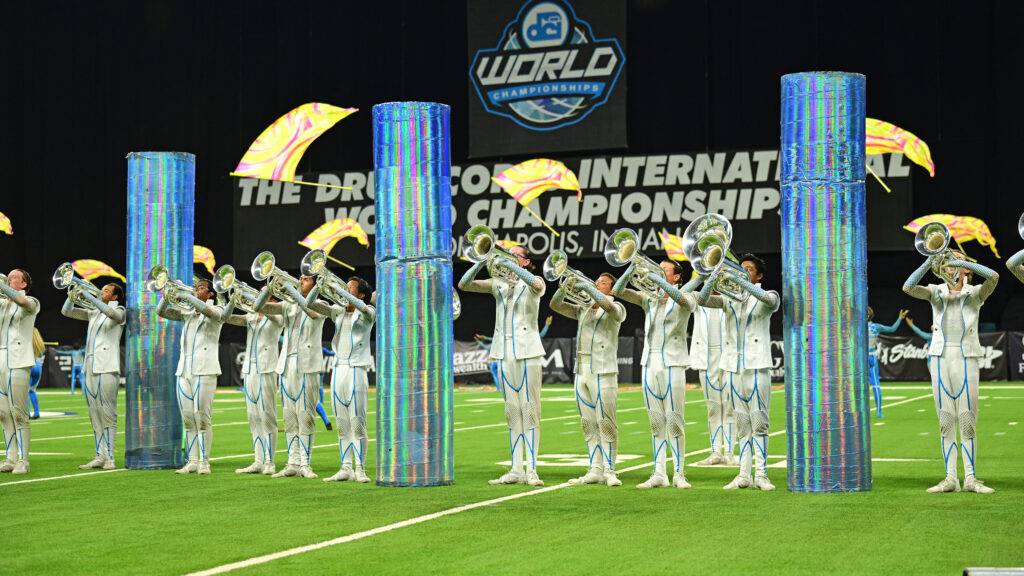
Foxboro Stadium, outside Boston, was home to the 1994 DCI World Championships, 11 years prior to DCI returning to the same site but a much larger Gillette Stadium. For the 7th time, Blue Devils walked away with the title, capping an undefeated season. Finals night represented a beginning and an end as spectators welcomed Magic of Orlando to the big show, while bidding a fond farewell to Don Pesceone, DCI’s Executive Director for more than two decades.
Blue Knights tied Crossmen in the Finals competition, finishing in 7th place. The entire production was based on a single piece of music, James Curnow’s “Trittico,” commissioned in 1988 as a test piece for the national championship of the Swiss Brass Band Association. (In traditional brass band contests, each band plays the same test piece as well as one of their own offerings.) The world of brass bands is growing in the United States, but it’s got a far deeper history in Europe, especially in the United Kingdom.
It’s been said that there were around 30,000 brass bands in the UK several decades ago, with most towns and neighborhoods having at least one. British-style brass bands are also prevalent in Australia, New Zealand, and Western Europe, most notably in Norway and Switzerland. James Curnow, a native of Michigan, is a composer of works for both brass bands and concert bands, developing his craft as an instrumental music educator in the elementary, high school and college levels.
He studied euphonium under the world renowned Leonard Falcone and conducting under famed director Harry Begian. The title of Blue Knights’ singular selection comes from “triptych,” a set of three musical compositions based on a common theme and performed together as one larger work. In his composition, Curnow set an opening fanfare and three extended variations on the American shape note hymn, “Consolation,” written by Charles Wesley in 1749.
Wesley, the younger brother of the Methodist Church’s John Wesley, wrote lyrics for more than 6,000 hymns, including the much performed “Hark! The Herald Angels Sing” and “Christ the Lord is Risen Today.” Blue Knights’ show was quite authentic to Curnow’s musical construction, opening with a big fanfare proclamation based on the melodic framework of the hymn tune’s theme. Fragments of that fanfare later appeared throughout the piece. The opening formation utilized the entire width and depth of the field, rapidly condensing the form during a drum intro into a company front stretching from goal line to goal line, quickly followed by a wide and shallow arc.
As the main theme developed, It made liberal use of setting the slow theme over a much faster pulse, followed by a subtle rising and falling of dynamics as the melodic line ascended and descended. The front ensemble mallet instruments intriguingly delved into a section of hemiola—the rhythmic layering of three beats evenly spaced over two counts—for the transition to the next variation.
This was a foretelling of the hemiola that was to come in the first variation. The first variation was a scherzo, a quick-paced, playful musical motif that reflected the minor tonality of the hymn tune, but in a spunky manner not normally associated with minor modes. Aggressive brass attacks punctuated the music, leading into an equally assertive drum break. The variation on the melody that followed interspersed those brass notes with rapid horn passages up and down the scale in the mid-voices, leading the transition to a major tonality and a flurry of dynamic fanfare-like reflections from the entire brass line. The second variation was tranquil, starting with the same notes as the original fanfare, but far more subdued.
A mellophone solo sailed over the lovely chords as the color guard members proceeded to the front line, removed the black blouses over their torsos and emerged emblazoned in solid white. Large white wide-brimmed headgear at first created an appearance as if the guard was carrying parasols. Also carrying flower baskets full of artificial flowers, the guard section vividly contributed to the solace and comforting strains of the music.
The brass players coalesced into the center of the field in a symmetrical formation right on the 50-yard line, with metallic pastel flags appearing symmetrically to each side, reflecting the colors of the flowers in the baskets. The second variation then musically tapered to a delicate nothingness, awaiting the stirring conclusion to the show.

Another scherzo section came in the third variation, combining the main theme with an ostinato, a repetitive rhythmic figure. The melody was happy and rhythmically tricky, jumping around the rhythmic beat and making one wonder just where count one was hiding.
Yellow rifles and yellow sticks with two sizes of yellow balls at the tops contributed to the sense of happiness that evolved out of the prior soulful contemplation. Toward the end of the work, there was a short aleatoric section, allowing the horn players to individually create their own music from prescribed patterns of pitches. (The word “aleatoric” is derived from “alea,” the Latin word for “dice” that refers to chance.)
During the last couple weeks of the season, this section became substantially less cacophonous and more structured; to the point that the aleatoric feel of this segment all but disappeared. The spirited finale of the piece brought together many of the prior musical elements in a glorious statement of vitality, the minor darker sense of the original theme asserting itself with a newfound brighter major key tonality.
A final restatement of the original theme led into a repeat of the forward field formation as seen in the original opening brass form, once again collapsing into a company front and then a giant arc. Some further brief evolutions of the musical theme and rapidly swirling drill maneuvers brought the show to a rousing conclusion.
For this week only, you can save on the Legacy Collection DVD that contains this complete Blue Knights performance, along with all finalists from the 1994 DCI World Championships.
Buy the 1994 Legacy Collection DVD. (Available this week only for 30% off. Regular price: $35.95.)
1994 Overview
Discount DVD offer ends Monday, May 5.

Michael Boo was a member of the Cavaliers from 1975-1977. He has written about the drum corps activity for more than a quarter century and serves as a staff writer for various Drum Corps International projects. Boo has written for numerous other publications and has published an honors-winning book on the history of figure skating. As an accomplished composer, Boo holds a bachelor's degree in music education and a master's degree in music theory and composition. He resides in Chesterton, Ind.





